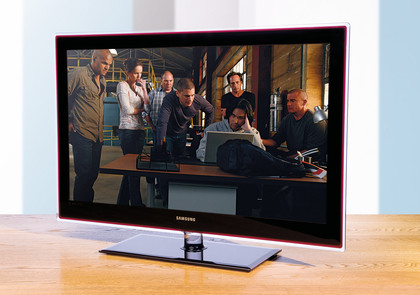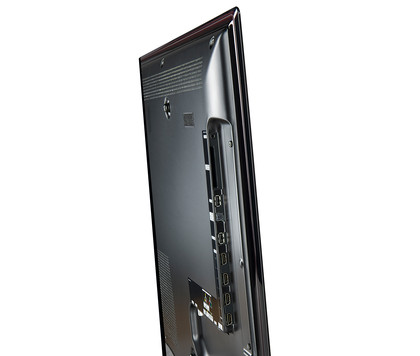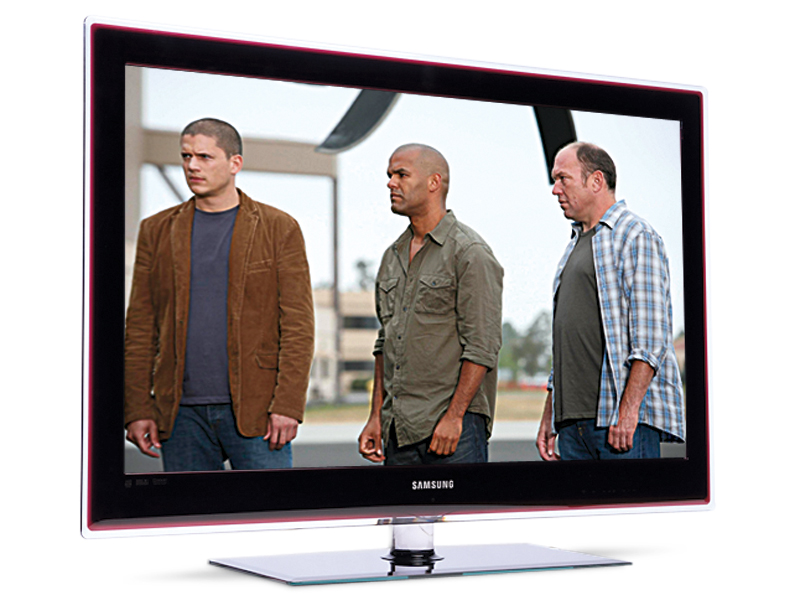TechRadar Verdict
Superb performance, top notch features and excellent value put this LED LCD right at the top of the pile
Pros
- +
Superb contrast
- +
Sharp HD images
- +
Glorious slim styling
- +
Multimedia and web widget extras
Cons
- -
Poor audio performance
- -
No wi-fi adapter included
Why you can trust TechRadar
At just over an inch in depth, the UE40B7000 is one of the thinnest HDTVs I've ever clapped eyes on. Most flat panel televisions are fairly skinny to start with, but Samsung has succeeded in making this 40in LED eye-poppingly, supermodel thin.
But don't for a second think that the company has stripped out the features and compromised on performance in order to achieve this pancake-like profile; the UE40B7000 comes with all the gubbins you'd expect from a top of the range LCD.
Behind the 1920 x 1080 resolution glass is a range of image enhancement technologies, including 100Hz scanning for smoother motion, and a full suite of digital media and networking features, including web-connected Yahoo! Widgets and DLNA compatibility for photo, music and video streaming. Which doesn't sound like a bad little lot for £1,250.
Beauty is in the eye of the beholder, of course, but I think most buyers will regard this TV as one of the best-looking sets around. Its thinness, of course, is a heck of a draw, especially if you plan on wall-mounting it, but there are plenty of other ways it appeals.
The gloss-black crystal finish (with a hint of red) is one of them – and how about that transparent column on the tabletop stand? Even the secondary remote (yes, Samsung gives you two different remote controls with this TV) looks cute, resembling, as it does, a small polished pebble (albeit a pebble with a power button on top).
LED on the side
The television's thinness comes from the fact that it uses edge-mounted LED lamps rather than a full back array of CCFL tubes mounted behind the screen. It's therefore similar to Sony's equally skinny KDL-40ZX1.
Sign up for breaking news, reviews, opinion, top tech deals, and more.
This arrangement offers lower power consumption (fewer lamps means less of a current suck) and a thinner profile than standard LCD TVs, but doesn't allow for the localised dimming seen on other LED screens like Philips' LED-backlit 42PFL9803H.
With this Samsung you get a reasonably uniform brightness across the screen, as it's not able to shut off the backlight in certain areas, thereby emphasising blacks.

DARK TIMES: The black levels on Samsung's UE40B7000 show how close LCD has come plasma's contrast levels
That's not to say the black levels on this TV are disappointing. Calibrate the screen using a standard test disc, and position yourself square on and you'll see almost plasma-like levels of deep, rich blacks, nicely complemented by bright whites and vibrant colours.
Samsung doesn't quote a specific contrast ratio (which is fine by me as manufacturers' contrast ratio claims rarely equate to real world performance), but simply calls this TV's performance 'Mega Contrast'. And in fairness, this isn't hyperbole – our tech labs recorded a contrast ratio of 308,562:1, which is, well, mega.
But do be aware that black levels drop off markedly if you're sitting to the side (or above or below) the screen. Off axis viewing angles are not great.
I also noticed a touch of unevenness in backlight brightness at times, with more light bleeding through in certain areas. This was only really evident on solid black screens with dynamic contrast switched off, however, so I imagine few viewers will find it a major problem.
Motion is smoothed out very effectively by the 100Hz processing, which can be adjusted by the user and switched off completely if necessary. Why would you want to do that? Well, there is the odd instance of an artefact around a moving object now and then, and some might find this an unwelcome distraction when watching movies.
HD pictures have real impact on this screen, particularly Blu-ray movies. The deep blacks and crisp edges the UE40B7000 provides help to deliver a picture that looks almost three-dimensional, with judder-free motion and eye-popping colour reproduction.
Standard-def content is decent too, and you get a couple of essential noise reduction modes to play with if you want to improve particularly dodgy source material (anyone out there still watching VHS tapes?).

BREAK OUT: HD sources are particularly strong on the Samsung screen
HD gaming also works slickly, with the LED backlighting holding up well even with the fastest-moving titles. By comparison, the LED-lit Philips 42PFL9803H often smeared colours working with the likes of Gears of War 2 and PES 2009, but here both games remain stable and clean.
Users have the option of selecting a pre-configured Game Mode, which cuts out the dynamic contrast and makes a few other changes, but it's not a must – you can get just as good results by doing some of your own tweaking.
Connectivity is reasonably impressive, with four HDMI inputs, supplemented by PC, component and Scart. The latter two, however, both require adapters (which are supplied in the box), as the TV is simply too thin to accommodate the usual connectors on its backplate.
There's also an optical digital audio output, plus a Common Interface card slot, a couple of USB 2.0 ports and an Ethernet socket for networking. A port for a wireless LAN adapter is also fitted, but the adapter itself will cost extra.
The screen's multimedia features are not to be sniffed at. Thus far, most digital media-compatible TVs I've seen have been fairly disappointing, but the DLNA compatibility here ensures that it works smoothly with a variety of file types.
I played an AVI movie directly from a USB storage key with no glitches and great picture quality – the only problem was that scanning forward and back was very slow. Likewise, JPEG photos looked sharp and MP3 music played without any grumbles. You can also stream content from any DLNA-equipped PC or Mac on your home network.

PLUG IT IN: Somehow, Samsung have fit a veritable bevy of connections into the UE40B7000
The networking function allows the TV to connect to the 'net via a router, and while there's no browser, you can access self-updating widgets from Yahoo! And users of the Flickr photo sharing website can enter their login details and stream their pictures and slideshows direct to the UE40B7000.
Entering passwords is a slow, sluggish and frustrating process here, but once it's done the whole thing works quite well. It's a nice bonus feature.
The aforementioned optical audio output should come in handy, because, to put it frankly, this TV's built-in speakers are next to useless. I wasn't expecting audiophile performance from such a thin cabinet, but the speakers are tinny and, when anything bassy comes on, prone to horribly distracting distortion. I wouldn't recommend the speakers for anything other than a news broadcast, basically.
Disappointing audio aside, Samsung has managed to whip up a fantastic television here. It's brilliantly thin and stylish, but still succeeds in delivering a high level of picture performance and some very useful digital media and web features. And all at a price that makes rival sets like the Sony KDL-40ZX1 and Philips 42PFL9803H look rather expensive in comparison.
Follow TechRadar Reviews on Twitter: http://twitter.com/techradarreview

Sam has been writing about tech and digital culture for over 20 years, starting off in video games journalism before branching out into the wonderful worlds of consumer electronics, streaming entertainment and photography. Over the years he has written for Wired, Stuff, GQ, T3, Trusted Reviews and PC Zone, and now lives on the Kent coast in the UK – the ideal place for a camera reviewer to ply their trade.
